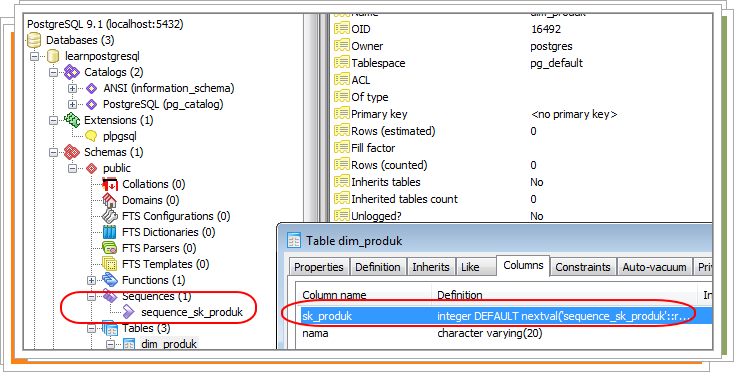Postgresql Auto Generated Primary Key
Summary: in this tutorial, you will learn about PostgreSQL foreign key and how to add foreign keys to tables using foreign key constraints. A foreign key is a field or group of fields in a table that uniquely identifies a row in another table. In other words, a foreign key is defined in a table that references to the primary key of the other table. For a relational database like PostgreSQL, it could widely be considered a sin among developers not to include a primary key in every table. It is therefore crucial that you do your utmost to add that all-important primary key column to every table, and thankfully Postgres provides two methods for accomplishing this task. Is a long field ok for a primary key, or should i use a unique integer?:. The popularity of auto-generated serial numbers as primary keys comes. That is generated using it will alert me to change to a new part in anything that uses it. I'm using postgresql from php script embedded in html (apache on debian, etc). In response to. Dec 08, 2017 Database Research & Development: PostgreSQL 10 introduced the concept of IDENTITY COLUMN which used for creating an auto-increment column, and it is also good then SEQUENCE Object. May 23, 2015 We see that each row has a UUID id field which is the primary key and was automatically generated for us. It was pointed out by @drewblas (thank you Drew!) that using genrandomuuid from pgcrypto has a negative side effect with respect to keyspace fragmentation on disk for the tables. Drew told us that.
- Postgresql Auto Increment Id Primary Key Pgadmin
- Postgresql Auto Increment Non Primary Key
- Postgresql Auto Generated Primary Key 2017
JPA and Hibernate support different strategies to generate primary key values. One of them is the identity strategy which uses an auto-incremented database column. If you want to use this strategy, you have to annotate the primary key attribute @Id and with the @GeneratedValue annotation and set the strategy attribute to GenerationType.IDENTITY. Learn how to define an auto increment primary key in SQL Server. This data tutorial will explain basic table creation and information around using identity a.

- PostgreSQL Tutorial
- Advanced PostgreSQL
- PostgreSQL Interfaces
- PostgreSQL Useful Resources
- Selected Reading
PostgreSQL has the data types smallserial, serial and bigserial; these are not true types, but merely a notational convenience for creating unique identifier columns. These are similar to AUTO_INCREMENT property supported by some other databases.
If you wish a serial column to have a unique constraint or be a primary key, it must now be specified, just like any other data type.
The type name serial creates an integer columns. The type name bigserial creates a bigint column. bigserial should be used if you anticipate the use of more than 231 identifiers over the lifetime of the table. The type name smallserial creates a smallint column.
Syntax
The basic usage of SERIAL dataype is as follows −
Example
Consider the COMPANY table to be created as follows −
Now, insert the following records into table COMPANY − Cs6 master collection serial key generator.
Postgresql Auto Increment Id Primary Key Pgadmin
This will insert seven tuples into the table COMPANY and COMPANY will have the following records −
Tom Lane wrote:
> Russell Shaw <rjshaw(at)iprimus(dot)com(dot)au> writes:
>
>>Is a long field ok for a primary key, or should i use
>>a unique integer?:
>
>
>>create table parts (
>> manufacturers_code char(40) primary key,
>> description char(40),
>> man_id int references manufacturers (man_id)
>>);
>
>
> There's nothing wrong with using a character field as primary key,
> but I'd advise you to think twice about defining it as char(40).
> Almost certainly you want varchar(40), so as not to be wasting huge
> amounts of space on padding blanks.
I'd assumed databases would save the number of blanks needed in any
position, and restore/add the blanks when the field was retrieved.
> For that matter, where did
> the '40' come from in the first place? Is there a really good
> application-driven reason to limit the codes or descriptions to 40
> characters? If your answer reveals that the number was picked out
> of the air, I'd suggest dropping the constraint entirely. Text or
> unconstrained varchar is a better choice, though it's not completely
> SQL-standard.
I assumed that for some reason it would be faster or more efficient
than something of unfixed length or else why does it exist? Maybe it
is only kept for compatability purposes?
> One thing you should think carefully about before using externally
> supplied data as a primary key is 'what happens if the manufacturer's
> code changes'? You'll have to update not only this table, but all
> references to it from other tables. It's usually considered good
> practice to choose primary keys that will *never* change, and that
> essentially means that they can't have any externally-imposed meaning.
> The popularity of auto-generated serial numbers as primary keys comes
> from this consideration.
Postgresql Auto Increment Non Primary Key
That is something hard to decide on. If a part becomes obsolete, i
thought maybe i could fill in an 'obsolete' field so that any report
that is generated using it will alert me to change to a new part in
anything that uses it.
Postgresql Auto Generated Primary Key 2017
I'm using postgresql from php script embedded in html (apache on debian, etc).